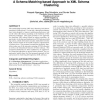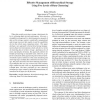BMVC
2010
14 years 5 months ago
2010
The Texture Fragmentation and Reconstruction (TFR) algorithm has been recently introduced [9] to address the problem of image segmentation by textural properties, based on a suita...
PR
2007
14 years 6 months ago
2007
In this paper, an evolutionary clustering technique is described that uses a new point symmetry-based distance measure. The algorithm is therefore able to detect both convex and n...
JMLR
2006
14 years 7 months ago
2006
Given a matrix of values in which the rows correspond to objects and the columns correspond to features of the objects, rearrangement clustering is the problem of rearranging the ...
ADHOC
2007
14 years 7 months ago
2007
We present a clustering technique addressing redundancy for bounded-distance clusters, which means being able to determine the minimum number of cluster-heads per node, and the ma...
NIPS
2004
14 years 8 months ago
2004
We propose a new method for clustering based on finding maximum margin hyperplanes through data. By reformulating the problem in terms of the implied equivalence relation matrix, ...
IIWAS
2008
14 years 8 months ago
2008
The relationship between XML data clustering and schema matching is bidirectional. On one side, clustering techniques have been adopted to improve matching performance, and on the...
CSMR
2009
IEEE
14 years 12 months ago
2009
IEEE
Decomposing a software system into smaller, more manageable clusters is a common approach to support the comprehension of large systems. In recent years, researchers have focused ...
MSS
2003
IEEE
15 years 13 days ago
2003
IEEE
When data resides on tertiary storage, clustering is the key to achieving high retrieval performance. However, a straightforward approach to clustering massive amounts of data on ...
ICCS
2005
Springer
15 years 20 days ago
2005
Springer
Abstract. This paper presents an innovative, adaptive variant of Kohonen’s selforganizing maps called ASOM, which is an unsupervised clustering method that adaptively decides on ...
ADBIS
2007
Springer
15 years 1 months ago
2007
Springer
In solving the classification problem in relational data mining, traditional methods, for example, the C4.5 and its variants, usually require data transformations from datasets sto...





